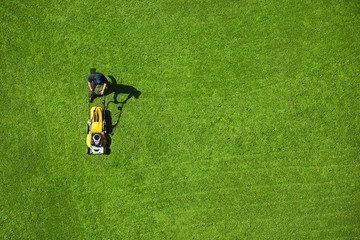Lawn care begins with what lies beneath the grass. The soil’s health plays the most crucial role in growth. Too often, lawns are treated on the surface only. This ignores the unseen root problems.
Microbial balance in soil affects how grass absorbs nutrients. Encouraging organic microbial activity fuels healthy turf. Aerating the soil rejuvenates compacted areas. This gives roots more room to grow. Contact PristineCutsLawnCare for professional help.
Using grass-specific mycorrhizae encourages better drought resistance. These beneficial fungi extend root systems naturally. They improve nutrient absorption efficiency. This reduces the need for heavy fertilization.
Lawn maintenance should adapt to climate shifts. Grass now faces unusual moisture and heat patterns. Seasonal plans must be flexible and responsive. Observation is now part of best practice.
Eco-friendly lawn formulas are evolving. Green chemistries are replacing toxic components. These options still manage pests and diseases effectively. They reduce harm to pollinators and pets.
Instead of routine mowing schedules, grass height should guide the cut. A higher blade protects roots from extreme heat. It also shades out aggressive weed growth. This creates more resilient turf.
Clipping recycling can strengthen soil naturally. Leaving clippings adds nitrogen back into the system. It reduces landfill waste from yard debris. Mulching mowers make this process easier.
Precision irrigation systems are gaining traction. These reduce water waste and runoff. Soil moisture sensors give real-time guidance. This prevents overwatering and fungal problems.
Lawn layout should match intended usage. High traffic areas may need tougher turf. Light footfall zones can handle delicate blends. Choosing the right seed mix matters.
Urban lawns benefit from vertical green layers. Adding moss walls or green steps expands usable space. These reduce heat islands in paved surroundings. It also creates micro-habitats for insects.
New blends of native grasses are gaining attention. They’re less demanding on water and care. These blends support local biodiversity. They also resist local pests better.
Lawn edges need as much attention as the center. Edging reduces soil erosion and keeps shape crisp. Strong barriers stop the invasion of unwanted plants. A clean edge elevates visual appeal.
Smartphone-based lawn monitoring tools now exist. These track fertilization, watering, and sunlight data. App alerts help avoid over-treatment. It’s a digital helper for beginners.
Low-mow lawns are growing in popularity. These use specific grass types that grow slower. They need fewer cuts per season. This saves fuel, time, and labor.
Rainwater harvesting supports lawn hydration. Captured water lowers utility costs. Natural rain lacks the treatment chemicals found in tap water. Grass thrives better under this gentle source.
Phosphorus levels should be tested before application. Overuse leads to water contamination. Responsible fertilization supports clean water sources. Lawn care must extend beyond boundaries.
Artificial light affects lawn growth near structures. Too much night light can disturb plant cycles. Light pollution also harms nocturnal pollinators. Shielded lighting designs can fix this issue.
Thermal weeding is a newer technique. It uses controlled heat instead of herbicides. The method targets weed root systems effectively. It’s chemical-free and safe around children.
Lawn diversity strengthens the overall system. Blending grasses with small clovers or herbs boosts nitrogen naturally. This reduces the need for synthetic products. Mixed lawns also withstand stress better.
Biochar is becoming a valuable soil amendment. It holds water and nutrients longer than regular compost. Biochar improves poor or sandy soil significantly. It’s a long-term investment for lawn health.
Seasonal layering of care is essential. Early spring needs different nutrients than fall. Using the same method year-round harms turf. Tailored care enhances growth consistency.
Insect presence doesn’t always mean infestation. Beneficial insects also reside in lawns. Observation and identification are key. Not all bugs need control.
Pet owners should rotate outdoor spaces. Constant pet traffic stresses one area too much. Recovery patches can be rotated and shielded. This prevents permanent damage and odors.
Drought-tolerant grasses are being bioengineered. These still look lush with minimal watering. It’s part of future-proofing the urban landscape. Traditional lawns may not survive climate extremes.
Soundscaping complements lawn spaces now. Strategically placing water features alters acoustic comfort. This adds serenity to outdoor areas. It increases enjoyment of lawn spaces.
Lawn furniture layout can impact growth. Heavy structures create soil compaction zones. Periodic relocation prevents permanent marks. Light materials are better for mobile setups.
Grass can also act as an air filter. Dense turf captures dust and airborne particles. This contributes to better respiratory health. Lawns are more than decoration.
Compost tea is another trend in lawn revival. This natural brew feeds microbial life. It spreads nutrients through soil layers. It’s a living tonic for lawns.
Reducing thatch buildup keeps turf breathable. Thatch suffocates roots and traps moisture. Periodic dethatching refreshes the lawn’s surface. It also reduces fungal growth risk.
Robotic mowers bring consistency in lawn upkeep. They trim lightly and often for better grass health. These also reduce noise pollution. More homeowners are exploring this technology.
Thermal mass techniques improve lawn temperature regulation. Rocks and water bodies store heat during cold seasons. This moderates extreme temperatures. It extends active growing periods.
Incorporating edible landscaping into lawns is trending. Herbs and greens coexist with turf. It turns lawns into food-producing areas. This aligns with sustainable living.
Zoysia plug systems are now more refined. These small grass plugs grow into thick carpets. They fill bare patches efficiently. It’s ideal for slow-growing lawn types.
Painted lawns are gaining niche use. Non-toxic grass paint revives faded greens. It’s a temporary fix during droughts. It restores visual appeal without real growth.
Carbon footprint analysis for lawns is now possible. This measures emissions from maintenance practices. Reducing mower use lowers the score. Lawn owners are more climate-aware.
Soil memory affects grass response over time. Poor habits embed stress into turf systems. Recovery takes time and patience. It’s better to build healthy routines early.
Lawns can also reduce surrounding temperatures. They cool surrounding air more than hardscapes. This contributes to urban cooling strategies. It’s part of passive design solutions.
Moon-phase gardening affects mowing timing. Some believe waxing moons promote vertical growth. Others swear by waning periods for root work. While debated, some enthusiasts follow it strictly.
Permeable lawn grids are solving drainage problems. They support grass while preventing flooding. These grids reinforce structure under soft soil. They’re ideal for car paths too.
Antifungal lawn soaps are being reformulated. New blends use natural oils and enzymes. These kill fungi without harming insects. It keeps lawns healthier long-term.
Grass cycling integrates with circular economy ideals. Everything that falls on the lawn feeds back into it. Clippings, rain, and even organic waste compost. It’s a zero-waste strategy.
Mobile lawn units are used in pop-up parks. These movable patches bring greenery anywhere. They’re used in events or on rooftops. It shows how versatile lawns can be.
Shifting to native pollinator strips boosts lawn support. It combines beauty and ecology. Flowers attract bees while grass frames the space. It’s a balanced, biodiverse mix.
Lawns can teach science to children. Growth cycles, weather impact, and composting are visible lessons. Parents can use lawns for learning. It’s a classroom under the sky.
Alternative textures are gaining momentum. Moss, thyme, and creeping sedums feel different underfoot. They offer soft cushions with minimal upkeep. They’re gentle and inviting to the senses.
Lawn zoning is a powerful planning tool. Each zone serves a specific function or care plan. It improves resource allocation. This avoids overwatering or over-fertilizing.
Aromatherapy lawns combine plants for scent. Lemon balm, mint, or chamomile enhance lawn strolls. Scents calm stress during outdoor relaxation. It’s therapy woven into the ground.
Color plays a bigger role than before. Not all lawns must be green. Purple-tinged grasses or mixed hues add depth. Color variation adds charm and uniqueness.
Increased interest in nighttime lawns leads to lighting solutions. Solar ground lights outline paths subtly. This extends usability after dark. It transforms a lawn’s function.
Insect hotels are being added to lawns. These help beneficial bugs like ladybugs and lacewings thrive. It balances natural ecosystems. Lawns now support entire micro-worlds.
Grass art is making its way into creative spaces. Patterns are mowed in to form temporary designs. It adds personality to events and gatherings. It’s a growing art form.
Lawns are being designed with sound barriers in mind. Grass mounds absorb city noise. This shields homes from nearby streets. It adds a protective function to beauty.
People are using lawn time as digital detox. Walking barefoot helps mental clarity. Grounding through grass aids emotional reset. It’s peace you can step into daily.
Lawn care isn’t a chore anymore. It’s a form of intentional living. Each blade has potential. Each patch holds meaning.
